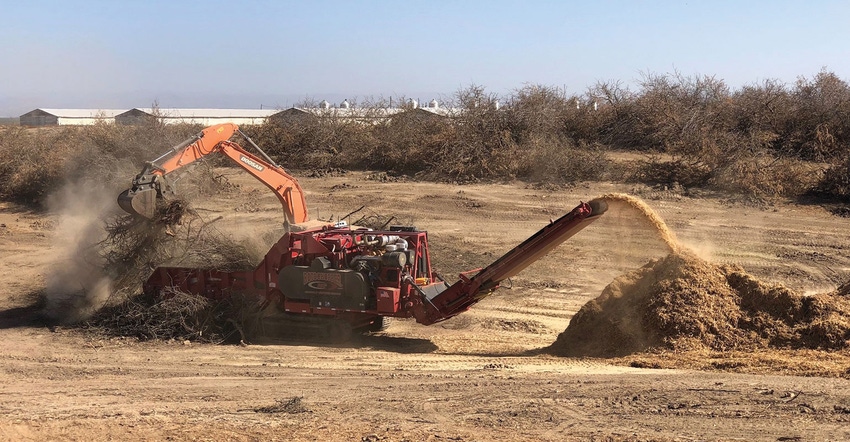
The next round of funding for the CDFA’s Health Soil Initiatives Program, where payments can cover almost half the cost of whole-orchard recycling, begins in July.
And it comes on the heels of a long-term study of whole-orchard recycling in almonds that “can increase crop yields in subsequent orchards (and) provide long-term soil health benefits like improved water retention and nutrient levels,” according to the Almond Board of California.
Citing decade-long study results (published in the journal PLOS ONE) comparing a WOR plot with one where burned tree ash had been tilled into the soil, the WOR plot consistently bested the tree ash orchard.
Researchers discovered that at ninth leaf, there was a 19% increase in yield along with a 30% increase in soil water-holding capacity and a 17% increase in total soil levels.
The Almond Board’s Sustainability and Environmental Affairs Director, Gabriele Ludwig, commented, “Almond growers have long been told that implementing practices to improve soil health will provide all these benefits, but until now there had been very little data demonstrating that a focus on feeding the soil with organic matter can make a meaningful difference in yield and quality of crop.”
If the proof is in the pudding, this study showed a potential for significant yield fitting nicely into ABC’s industry effort to produce ‘more crop-per-drop’ as part of its Almond Orchard 2025 goals to reduce water use.
“Increased water-holding soil capacity as a result of WOR means trees are subject to fewer extremes in terms of water availability with more liquid held in the upper soil level where the majority of the tree’s roots are and where uptake takes place,” noted Ludwig.
While the research data showed an increase in soil water retention up to 30%, it was not a specific recommendation for growers to use less water if they practice WOR, merely that applied water is used more efficiently in WOR orchard trees.
“In WOR plots, water was more likely to reach — and be used by — the trees, allowing for increased yields because of less short-term stress and greater water use efficiency,” Ludwig added.
‘An urgent need’
In writing about the efficacy of the WOR concept, author Amelie Gaudin, agroecology professor at the UC Davis Department of Plant Sciences, emphasized, “There is an urgent need to develop climate-smart agroecosystems capable of mitigating climate change and adapting to its effects. In California, increased drought has encouraged orchard turnover, providing an opportunity to recycle tree biomass in situ, prior to replanting an orchard. Whole orchard recycling has potential as a carbon negative cultural practice to build soil health and orchard productivity.”
Her research article advised, “We suggest that in situ biomass recycling can be considered as a climate-smart practice in California’s irrigated almond systems.”
Writing for her College of Agricultural and Environmental Sciences Department, she added: “This study suggests that whole orchard recycling can help almond orchards be more sustainable and drought resilient while increasing soil carbon storage.
“To me, what was most impressive, was the water piece. Water is central to how we think about agriculture in California (and) this is a clear example of capitalizing on soil health. It’s here that we see some real benefits for water conservation and for growers.”
Gaudin reports further that drought and almond pricing have encouraged higher rates of orchard turnover in recent years and without the ability to burn trees as part of restricted air quality regulations, whole orchard recycling presents itself as a beneficial alternative.
In the 10-year-long experiment that concluded WOR increased water-use efficiency and crop yield while sequestering carbon, “This seems to be a practice that can mitigate climate change by building soil potential to be a carbon sink while also building nutrients and water retention, especially important as water becomes more limited.”
Read more about:
AlmondsAbout the Author(s)
You May Also Like




